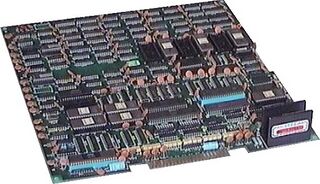Difference between revisions of "Sega System 1"
From Sega Retro
(→Memory) |
|||
| Line 82: | Line 82: | ||
====Memory==== | ====Memory==== | ||
{{multicol| | {{multicol| | ||
| − | * Memory: 111.8125 [[Byte|KB]] ( | + | * Memory: 111.8125 [[Byte|KB]] (50 KB main, 51.8125 KB video, 10 KB sound) |
* [[RAM]]: 6.28125 KB | * [[RAM]]: 6.28125 KB | ||
** Main: 2 KB | ** Main: 2 KB | ||
Revision as of 20:47, 5 October 2016

| |||||
| Sega System 1 | |||||
|---|---|---|---|---|---|
| Manufacturer: Sega | |||||
|
The Sega System 1 is an arcade platform officially debuted by Sega in 1983,[1] based on earlier 1982 prototype hardware. It is a Z80-based platform and the first in the decade-long "System" series of arcade boards.
The System 1 was a relatively popular arcade board for its day, supported not only by Sega, but by Japanese developers Coreland and VIC Tokai between 1983 and 1987. In 1985 it was succeeded by the slightly more powerful Sega System 2 board, though new games were released for both systems concurrently. Many of the System 1's games were ported to the SG-1000 and Sega Master System consoles.
Contents
Specifications
System 1
Graphics
- Graphics chipset:[2]
- Sega 315-5011 sprite line comparator
- Sega 315-5012 sprite generator
- Sega 315-5049 tilemap generator
- Video resolution: 256×224 (active), 640×260 (overscan)[2]
- Color palette: 4096[3]
- Colors on screen: 2048[2]
- Sprite plane: Line buffer, double buffering, 32 sprites on screen, 16 colors per sprite, sprite flipping, hardware collision detection[3][2]
- Background planes: 2 tilemap layers (1 static, 1 scrolling), 8×8 tiles[3][2]
- Tilemap sizes: 256×256 for both planes
Memory
Prototype
Super Locomotive in 1982 ran on prototype arcade hardware that was very similar to the Sega System 1 later released in 1983. Super Locomotive had largely identical specifications, but with the following differences:[5][6][7]
Graphics
Memory
Gallery
List of Games
- Super Locomotive (prototype hardware) (1982)
- Star Jacker (1983)
- Regulus (1983)
- Up'n Down (1983)
- Bull Fight (1984)
- Flicky (1984)
- Mister Viking (1984)
- Spatter (1984)
- SWAT (1984)
- Water Match (1984)
- 4D Warriors (1985)
- Choplifter (1985)
- I'm Sorry (1985)
- My Hero (1985)
- Pitfall II (1985)
- Sega Ninja (1985)
- Teddy Boy Blues (1985)
- Brain (1986)
- Gardia (1986)
- Noboranka (1986)
- Rafflesia (1986)
- Wonder Boy (also released on Sega System 2) (1986)
- Wonder Boy Deluxe (1986)
- Block Gal (1987)
References
- ↑ 1983 Timeline (Sega Corporation)
- ↑ 2.0 2.1 2.2 2.3 2.4 2.5 2.6 2.7 Sega System 1 / System 2 (MAME)
- ↑ 3.0 3.1 3.2 System1 / System 2 video hardware (MAME)
- ↑ Star Jacker (MAME)
- ↑ Super Locomotive (MAME)
- ↑ Super Locomotive video hardware (MAME)
- ↑ Sega Z80 Based Hardware (System 16)
- ↑ Super Locomotive (MAME)
| Sega arcade boards |
|---|
| Originating in arcades |
|
77
78
79
80
81
82
83
84
85
86
87
88
89
90
91
92
93
94
95
96
97
98
99
|
| Console-based hardware |
|
84
85
86
87
88
89
90
91
92
93
94
95
96
97
98
99
00
01
02
03
04
05
06
07
08
09
10
11
12
13
14
|
| PC-based hardware |
|
05
06
07
08
09
10
11
12
13
14
15
16
17
18
19
20
21
22
23
|

